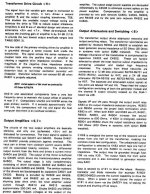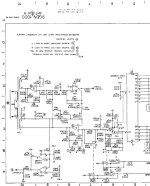john curl said:[snip]Now, everyone, think of dynamic DC offset inherent in the asymmetry of the audio signal passing through the transformer.
"Dynamic DC offset"? Didn't we use to call that "AC"?
Anyway, Dimitri partly beat me to it, but here's what AP says: these are the amps A & B that drive the xformer.
Jan Didden
Attachments
john curl said:I sent graphs to SY. Please get them from him.
What do I need the graphs for?
I gave you the test conditions for the JT-16-A's datasheet. What were the test conditions for the datasheet you have? Can't you simply state them as I did?
se
janneman said:... and for completeness, the drive circuit itself:
It's upside down. When did you move to Australia? 😀
se
Yes, SE, the graphs prove me most accurate, and you --------.😀 Don't bother, maybe, just maybe, they 'improved' the transformers with a new breakthrough, or a better alloy. That's OK with me, it is just a matter of magnitude, principle is the same.
Everyone else, I really think that Deane Jensen worked hard to make these transformers as good as they came out to be. He did not 'build' them, but he did model them accurately. Now that he is gone, many will take over the responsibility for the designs.
john curl said:Still, I have graphs that back up my EVERY WORD.
The graphs only back up what you said about the graphs. It doesn't back up your claims that Jensen is hiding anything or being dishonest with their measurements.
It would be interesting if the Jensen transformers suffer from this problem, what about other transformer manufacturers?
It's the nature of the core material itself, John. Not who makes the transformer.
Didn't you see the graph posted by dimitri showing the curves for M6, 49% nickel and 84% nickel? It's a result of the core material's hysteresis.
Here's the same graph of the CineMag CMMI-2C which is also a 1:2 microphone step-up transformer:
An externally hosted image should be here but it was not working when we last tested it.
Does negative Z drive fix this problem?
Yes.
se
john curl said:Scott, Bob Widlar told me to build my own preamplifier designs and not to descend to using IC's, (like you make), for audio, at an ISSCC conference in 1974. Ask Walt Jung, if you don't believe me.
Of course! Just as it is futile to try to built comfortable cars that seat 4, go 80mph on 20mpg. James Watt himself told me, in 1896, at a Steam Conference.
Get real, John!
Jan Didden
Graph does not go low level enough, Steve. I want to see -40dB like Dean showed in his original graphs. That is where the 'action' is.
john curl said:Yes, SE, the graphs prove me most accurate, and you --------.😀
What I said was, the graphs only back up what you said about the graphs. What you have been using these graphs for is to claim that Deane was honest, and that Bill is not. And so far, I have not seen any conclusive evidence of that.
You won't even say what the test conditions were for making the graphs. Why is that?
se
Let's assume that THD in a transformer increases at low levels like - 40dB.
What could the mechanisms / causes be for this increase?
Sigurd
What could the mechanisms / causes be for this increase?
Sigurd
Sigurd Ruschkow said:Let's assume that THD in a transformer increases at low levels like - 40dB.
What could the mechanisms / causes be for this increase?
Sigurd
AES 7125, Menno vanderVeen:
ABSTRACT: At the threshold of audibility, the signal and flux density levels in an amplifier with audio transformers are very small. At those levels the relative magnetic permeability of the
iron transformer core collapses and the inductance of the transformer becomes very small. The impedances connected to the transformer plus its signal level and frequency dependant
inductance behave as a high pass filter which corner frequencies slip into the audio bandwidth, resulting in a non linear signal transfer through the transformer. This research explains
deviations in the reproduction of micro details at the threshold of audibility."
Something like that? Note that one of us here has tried to duplicate this without succes. Note also the repeated use of the phrase "at the treshold of audibility"...
Jan Didden
john curl said:Macka, I might agree that we need a break, but I hope that you learned something from all this. If not, then it is you who has the biggest problem. You have to see below the aggressive discourse and learn the material. Many people here have some poor ideas about transformers. To some, they are obsolete, like tubes. To others, they are the saving grace of their hi fi's, and they must, therefore, be virtually perfect. Neither view is really accurate.
John,
Calm down.
I dont think anyone learns anything from just reading internet threads.
Sure you might garner some awareness and appreciation but learning is about undertanding and applying the knowledge to a problem and practical experience.
I worked as a head of business with scientists in manufacturing for defence for over ten years. Being technical or having experience in one aspect of your field does not make you god's gift to the industry. The top people never talked much about how much they knew but they were very employable and got on with everyone.
As far as audio vacational interest goes learnt a lot from Paul Stamler's articles in Audio Amateur 1995 on mixers and mike preamps as I am sure thousands of other reads did after building their projects based on what they picked up from Paul.
Nelson Pass and Erno Borbely have also written excellent articles of an educational nature. The late John Eargle and JL Hood are among my favourite authors on audio and electronics.
How many books have you written on audio engineering?
Ian
macka said:I dont think anyone learns anything from just reading internet threads.
😱
So I am the exception here.
I definitely have learnt quite a lot reading some threads here or elsewhere.
Might have to do with the fact that my receiver antennas are generally better than my transmitting antennas.
Tino
Ian, I find your attitude disturbing. I know most of the authors that you referred to. However, I am not in the business of writing books, and most engineers aren't as well.
Ian, when it comes to audio, your standard of excellence is lower than mine. We would not have gone to the moon in '69 with such a low standard of engineering acceptance.
Just before John Eargle died, we openly debated on the floor of the AES exhibition in San Francisco of the sorry state of the AES. He thought it was OK, I thought it disappointing. We had worked together in 77-78 with Harmon International.
I first met Erno in Switzerland in 1974. We would have lunch in Geneva overlooking the lake, talking for hours about great designs. Where do you think this 'crosstalk' comes from?
I met Nelson Pass in San Francisco about 1977. The first thing that he said to me was something like 'let's drink' which is wonderful input to a heavy drinker, but in the end, unlike some other designers, such as Jon Iverson, he found my behaviour wanting, and he had little to do with me in future. (and still I had to drive home, those were the days!)
Now Dimitri has independently compiled about 150 pages of my input, now easily accessable on this website. You should avail yourself to this input, and perhaps learn something new.
For the record, I generally do not publish my latest schematics, as I actually get paid to design them to a higher standard than usually found around here, and I am going to keep it that way.
Ian, when it comes to audio, your standard of excellence is lower than mine. We would not have gone to the moon in '69 with such a low standard of engineering acceptance.
Just before John Eargle died, we openly debated on the floor of the AES exhibition in San Francisco of the sorry state of the AES. He thought it was OK, I thought it disappointing. We had worked together in 77-78 with Harmon International.
I first met Erno in Switzerland in 1974. We would have lunch in Geneva overlooking the lake, talking for hours about great designs. Where do you think this 'crosstalk' comes from?
I met Nelson Pass in San Francisco about 1977. The first thing that he said to me was something like 'let's drink' which is wonderful input to a heavy drinker, but in the end, unlike some other designers, such as Jon Iverson, he found my behaviour wanting, and he had little to do with me in future. (and still I had to drive home, those were the days!)
Now Dimitri has independently compiled about 150 pages of my input, now easily accessable on this website. You should avail yourself to this input, and perhaps learn something new.
For the record, I generally do not publish my latest schematics, as I actually get paid to design them to a higher standard than usually found around here, and I am going to keep it that way.
ABSTRACT: At the threshold of audibility, the signal and flux density levels in an amplifier with audio transformers are very small. At those levels the relative magnetic permeability of the
iron transformer core collapses and the inductance of the transformer becomes very small. The impedances connected to the transformer plus its signal level and frequency dependant
inductance behave as a high pass filter which corner frequencies slip into the audio bandwidth, resulting in a non linear signal transfer through the transformer. This research explains
deviations in the reproduction of micro details at the threshold of audibility."
Using a high-quality Mu-Metal core goes a long way in eliminating this problem. I wonder if vanderVeen was referring to output transformers with GOSS cores (his specialty).
John
I don't know, but I sure couldn't duplicate his results using decent-quality E-I core output transformers. And I certainly don't see (nor does Jensen) the rise in distortion at low levels with the JT-11P1.
It appears that Menno was referring to VERY cheap iron cores, not anything more upscale.
It appears that Menno was referring to VERY cheap iron cores, not anything more upscale.
- Status
- Not open for further replies.
- Home
- Amplifiers
- Solid State
- John Curl's Blowtorch preamplifier


